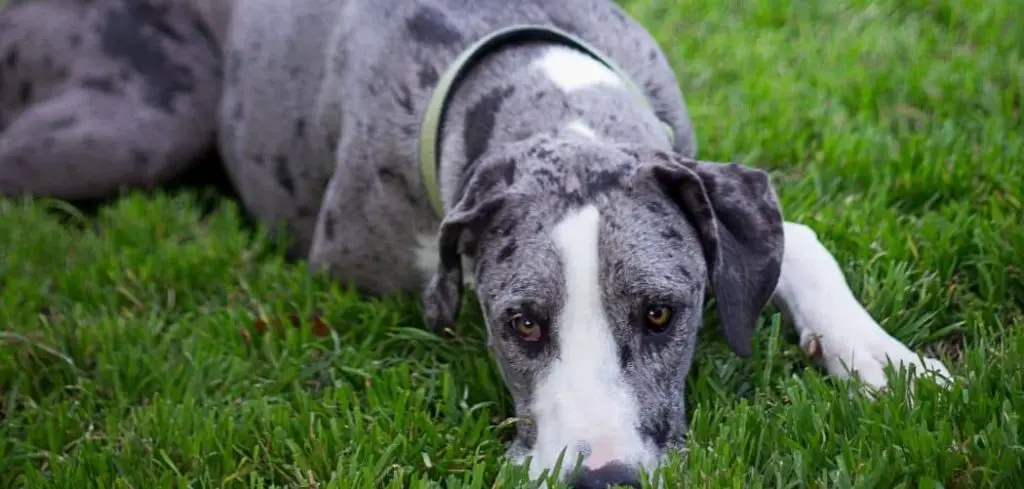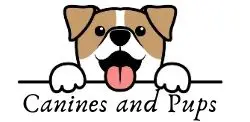Hair loss in Great Danes can be concerning, but understanding the root causes can help you take the necessary steps to keep your dog healthy.
We outline the common reasons for Great Dane hair loss, treatment options, and preventive measures to ensure your gentle giant maintains a thick and shiny coat.
Common Causes of Hair Loss in Great Danes

1. Allergies and Skin Irritations
Great Danes are prone to allergies, which can result in hair loss. Common allergens include:
Food allergies (grain, chicken, or dairy products)
Environmental allergies (pollen, dust mites, or mold)
Flea allergies (flea saliva can trigger extreme itching and shedding)
Symptoms of allergies in Great Danes include itching, redness, and bald patches.
A veterinarian may recommend an elimination diet or allergy testing to determine the trigger.
2. Hormonal Imbalances
Hormonal disorders like hypothyroidism and Cushing’s disease can lead to hair thinning in Great Danes.
Hypothyroidism: When the thyroid gland doesn’t produce enough hormones, it leads to lethargy, weight gain, and hair loss.
Cushing’s Disease: This condition results from excess cortisol production, leading to hair thinning, potbelly appearance, and increased thirst.
If you notice these symptoms, a vet may perform blood tests to diagnose hormonal issues and recommend appropriate treatment.
3. Parasites (Mites, Fleas, and Ticks)
Parasites such as mange mites, fleas, and ticks can cause severe skin irritation and hair loss in Great Danes.
Demodectic Mange: Caused by Demodex mites, leading to patchy hair loss, redness, and scaling.
Sarcoptic Mange: Highly contagious and causes intense itching and crusty skin patches.
A veterinarian can prescribe medicated shampoos, oral treatments, or topical solutions to eliminate parasites.
4. Poor Nutrition and Diet Deficiencies
A lack of essential nutrients can lead to a dull coat and excessive shedding.
If your Great Dane is losing hair, ensure their diet includes:
High-quality protein for skin and coat health
Omega-3 and Omega-6 fatty acids for coat shine
Vitamins and minerals like zinc and biotin for skin repair
Switching to a well-balanced, high-quality dog food can improve coat health and reduce hair loss.
5. Stress and Anxiety
Just like humans, Great Danes can experience stress and anxiety, leading to excessive licking, chewing, and hair loss. Causes of stress in Great Danes include:
Separation anxiety
Loud noises (fireworks, thunderstorms)
Changes in environment
Reducing stress through regular exercise, mental stimulation, and positive reinforcement training can help prevent excessive shedding.
6. Genetic and Hereditary Conditions
Some Great Danes inherit conditions that cause hair loss. One such condition is Color Dilution Alopecia (CDA), which affects blue and fawn-colored Great Danes. This genetic disorder leads to hair thinning and bald spots, especially along the back and ears.
While there is no cure, supplements like fish oil and special shampoos can help manage the symptoms.
7. Fungal and Bacterial Infections
Skin infections, such as ringworm (a fungal infection) or bacterial dermatitis, can lead to bald patches and scaly skin. Signs include:
Circular bald spots
Red, inflamed skin
Odor from affected areas
Veterinarians typically prescribe antifungal or antibiotic treatments to clear up the infection.
How to Treat Hair Loss in Great Danes
Once you identify the cause of your Great Dane’s hair loss, you can begin appropriate treatment.
Veterinary Diagnosis and Treatment
If your Great Dane has excessive shedding or bald spots, visit your vet for a thorough examination. Diagnostic tests may include:
Blood work: Identifies hormonal imbalances such as hypothyroidism or Cushing’s disease.
Skin scrapings: Detects parasites like mites and fungal or bacterial infections.
Allergy testing: Determines environmental or food allergies causing hair loss.
Treatment depends on the diagnosis and may include medicated shampoos, antihistamines, antibiotics, or hormone therapy.
Dietary Improvements
Proper nutrition plays a crucial role in maintaining a healthy coat. Consider:
Switching to a high-protein diet with real meat as the first ingredient.
Adding Omega-3 and Omega-6 fatty acids (found in fish oil) to reduce inflammation and improve skin health.
Supplementing with Biotin and Zinc to strengthen hair follicles and reduce shedding.
Regular Grooming and Skin Care
Maintaining a consistent grooming routine can prevent excessive shedding and hair loss:
Brush your Great Dane at least twice a week to remove loose hair and improve circulation.
Bathe them with hypoallergenic shampoo to soothe skin and prevent irritation.
Use flea and tick preventatives to avoid parasite-related hair loss.
Reduce Stress and Anxiety
A calm and stable environment helps minimize stress-induced hair loss:
Ensure daily exercise and playtime to release built-up energy.
Use calming aids, such as pheromone diffusers or anxiety wraps, for high-stress situations.
Create a predictable routine to provide security and comfort.
Medications for Skin Conditions
If hair loss is due to infections or allergies, a vet may prescribe:
Topical or oral flea treatments to eliminate parasites.
Antihistamines or steroids for severe allergic reactions.
Antifungal creams and medicated shampoos for ringworm and bacterial infections.
How to Prevent Hair Loss in Great Danes
While some hair loss is unavoidable, taking preventive steps can minimize excessive shedding and bald spots.
1. Maintain a Healthy Diet
A well-balanced diet with high-quality ingredients ensures a strong, healthy coat. Look for dog food rich in:
Lean proteins to support hair growth.
Essential fatty acids to keep the skin moisturized.
Vitamins and minerals to strengthen hair follicles.
Related: Why Is My Great Dane Not Eating? (Explained)
2. Regular Vet Checkups
Annual vet visits help detect early signs of skin conditions and hormonal imbalances. Early intervention can prevent severe hair loss.
3. Consistent Grooming Routine
Brush your Great Dane regularly to remove dead hair and distribute natural oils.
Bathe them every 4-6 weeks with a mild, skin-friendly shampoo.
Check for lumps, redness, or signs of irritation during grooming sessions.
4. Parasite Prevention
Protect your Great Dane from fleas, ticks, and mites by:
Using monthly flea and tick preventatives.
Keeping their bedding clean and washing it frequently.
Checking for parasites regularly, especially during warmer months.
Related: Why is my Great Dane shedding so much ? (Here’s Why)
5. Monitor for Signs of Allergies
Watch for itching, redness, and rashes. If your Great Dane develops allergy symptoms:
Identify and eliminate food allergens through an elimination diet.
Limit exposure to pollen and dust by keeping their environment clean.
Consult a vet for antihistamines or allergy-specific treatments.
Key Takeaway
There are multiple possible causes for a Great Dane’s hair loss, ranging from allergies and parasites to genetic conditions and hormonal imbalances.
By identifying the underlying issue and implementing appropriate treatments, you can help your Great Dane maintain a healthy, thick coat.
Regular vet checkups, a high-quality diet, and stress management are key to preventing hair loss in your beloved dog.
